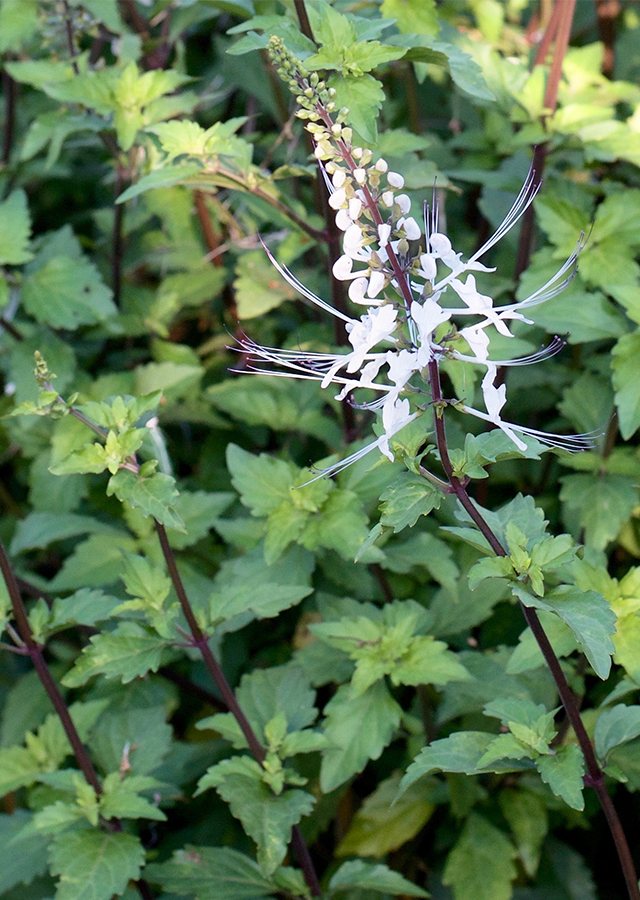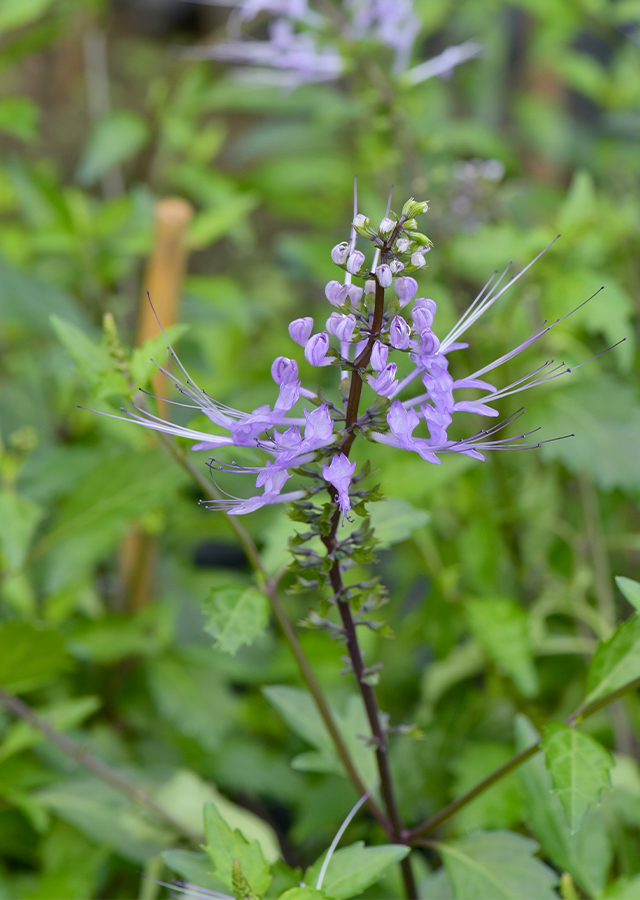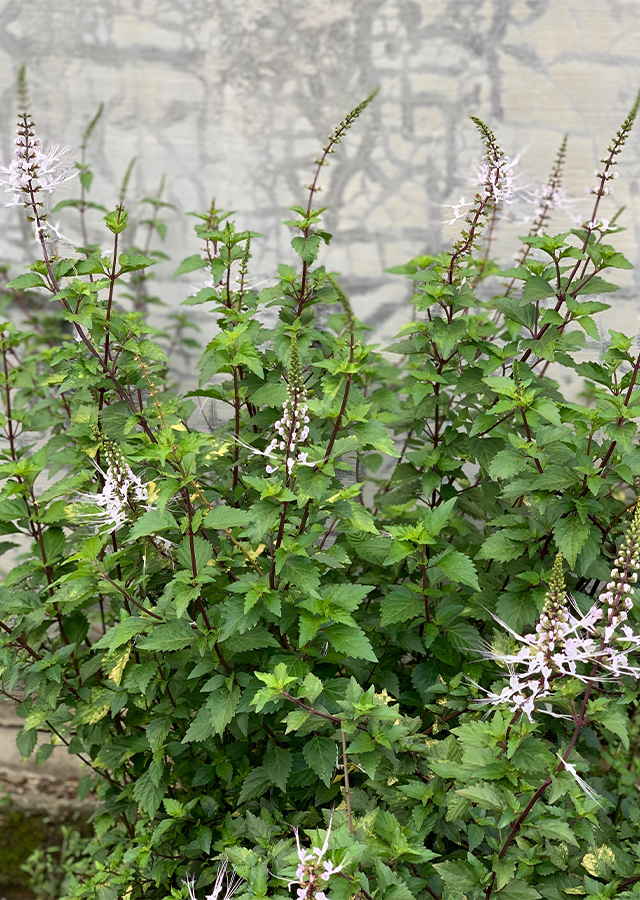Cat's whiskers
Orthosiphon aristatus (Blume) Miq.
Lamiaceae
Location in our garden
Principal



Synonym
Ocimum aristatum Blume
Habitus
Herbaceous. A fast-growing perennial herb, erect, poorly branched, 1-1.5 m tall.
Part Used
Leaves
Flowers
Twigs
Growing Requirements
Full Sunshine
Need Shade
Habitat
Forest
Roadside
Shrublands
Grassland
Overview
Cat's whiskers is a medicinal herb found mainly throughout southern China, the Indian Subcontinent, South-East Asia, and tropical Queensland. The plant is used in landscaping to attract bees, butterflies, and hummingbirds to its nectar. It is cultivated for its medicinal uses, and as an ornamental plant in the gardens as its flower is unique and beautiful.
Vernacular Names
Mao xu cao (Chinese), Moustaches de chat (French), Nek no hige (Japanese), Misai kucing (Malaysia), Kabling-gubat (Philippines), Yaa-nuat-maeo (Thai).
Agroecology
Orthosiphon aristatus can be grown and cultivated on any soil type including sandy soil like bris and tin tailings. The plant needs an average monthly rainfall of 180-200 cm to grow well. Irrigation should be provided during the dry season. It can withstand waterlogged conditions. The growth is not affected although the crop has been waterlogged for 24 hours. The soil pH required for optimum crop growth is 5-6.
Morphology
- Root - taproot.
- Stem - quadrangular and had an ascending stem, the dominant color mix of strong yellowish-green and deep purplish pink.
- Leaves - dark green, in distant pairs, smooth, narrowed into the stalk, ovate, 5-10 cm long, cuneate at the base, acuminate at the apex, coarsely toothed at the margins.
- Flowers - borne in very lax racemes, the calyx is bell-shaped with a naked throat and two slender lower teeth. Corolla is 2.5 cm long, smooth, white or purplish.
- Fruits - split into 4 oblong ovoid nutlets measuring 1.5-2 mm long with a brownish color and rugose surface.
Cultivation
- Vegetative propagation by stem cutting, 15 - 20 cm long, which have some buds, planted in shade, with 40 - 60 cm between plants and rows.
- Reproductive propagation by seed. After 4-5 weeks in the nursery, the seedlings are ready to be transplanted.
Chemical Constituents
Various types of chemical compounds that have been isolated from Orthosiphon aristatus species include monoterpenes, sesquiterpenes, diterpenes, triterpenes, flavonoids, steroid, caffeic acid, saponins, a glycoside (orthosiphonin), an essential oil. Other studies revealed different things that the chloroform fraction of boiled water leaves the cat whiskers containing isopimaran type dihydrogen compounds. Cat whiskers contain percentages of sinensetin, eupatorin, and 30-hydroxy-5,6,7,40-tetrametoksiflavon in chloroform extracts are 1.48%, 2.26% and 0.58%, respectively. Leaf extract of O. aristatus contains three flavonoids (30-hydroxy-5,6,7,40-tetrametoksiflavon, sinensetin, and eupatorin) as bioactive substances.
Traditional Medicinal Uses
- The diuretic effects of the leaves had been recognised in the South-East Asian community for the treatment of various kidney stones.
- The plant is considered anti-allergic, anti-inflammatory, anti-bacterial, hypoglycemic, antioxidant, anti-tumour, hypouricemic, nephroprotective, anti-diabetic, antihypertensive, antimicrobial, hepatoprotective, antifungal.
- The leaves are also used in the treatment of cystitis, urethritis, and gout.
- The leaves, stems, roots, and flowers have an antimicrobial effect.
- The leaves decoction has been prescribed in Javanese traditional medicine (jamu) for the treatment of hypertension, rheumatism, and diabetes, and is also used as a tea to facilitate body detoxification.
- Fresh leaves are chewed and swallowed to induce vomiting while the dried leaves are soaked in boiling water to aid urinary process allergy treatment, diabetes, and bloated stomach.
- In Myanmar, crushed fresh leaves are used on ulcers and wounds to reduce inflammation reactions.
Part Used
Reference Sources
- Chai, T.T., Wong, F.C., Manan, F.A., Ooh, K.F. & Ismail, N.I.M. (2014). Orthosiphon aristatus: A review of traditional uses, phytochemical profile, and pharmacological properties. Traditional and Eolk Herbal Medicine: Recent Researches 2: 153-187.
- Silalahi, M. (2019). Orthosiphon stamineus Benth (Uses and Bioactivities). Indonesian Journal of Science and Education 3(1): 26-33.


